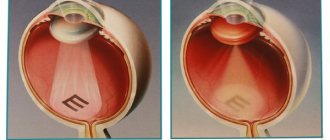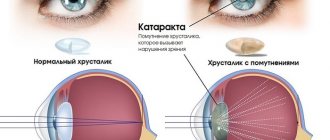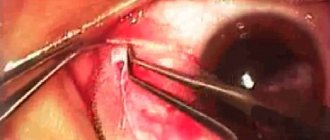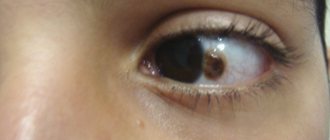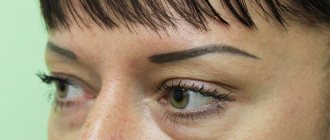Pterygium, commonly known as “meat in the eye,” is a condition that affects up to 25% of the population in some countries. Its main feature is the growth of fleshy, pink tissue in the eye (see photo below), which in some cases can cause vision problems, discomfort, dryness, inflammation, irritation and discomfort due to the presence of flesh, which, of course, is not part of the eye. eyes, and also be a significant aesthetic problem for people suffering from this disease.
Next, we will talk in detail about eye pterygium so that readers can better understand what it is, the reasons for its occurrence, as well as methods for treating this problem. In addition, we will also share some prevention tips.
What is pterygium in the eye?
A pterygium (pterygium) is a growth of tissue on the conjunctiva, or mucous membrane that covers the white of the eye near the cornea. Although it may seem scary, the tissue is benign and usually does not cause problems or require treatment unless it is interfering with vision in some way.
Typically, the pterygoid hymen forms on the side closest to the nose and grows towards the pupil, and growth can occur gradually and slowly over many years. At some point in time it may stop growing. Pterygium occurs in either one or both eyes; when the disease affects both eyes, it is called bilateral pterygium.
This pathology is not classified as a serious disease, but can cause unpleasant symptoms. Some people sometimes require medical or surgical intervention, especially when the pterygium covers the entire eye, causing vision problems.
Treatment of pterygium and recovery period after surgery
Treatment of pterygium is surgical. Before the operation, the doctor may prescribe anti-inflammatory and antiallergic drops to relieve inflammation. Glucocorticosteroid drugs may also be used. To prevent the mucous membrane from drying out, the specialist prescribes tear replacement therapy (artificial tears).
If surgical intervention is still required, the patient is prescribed surgery to remove the pterygoid hymen using the latest techniques. Such treatment is necessary in case of decreased vision, astigmatism, limited movement of the eyeball, and frequent relapses of the disease. In these cases, the following types of operations are used:
- conjunctival transplantation, when the pterygoid growth is completely removed and healthy conjunctival tissue is transplanted to this place;
- transplantation of the amniotic membrane, which acts as a substrate for replacing damaged tissue;
- removal of pterygium with a laser beam;
- keratoplasty with the replacement of damaged corneal tissue with a donor graft.
Beta irradiation, metabolites, and doxycycline therapy are sometimes used as additional methods. After surgery, the cornea of the eye is very sensitive to any external influences. Therefore, it is important to prevent subsequent complications. In the first postoperative days, you need to get used to the fact that your vision will be blurry. The rehabilitation period can last several weeks. This is necessary to fully restore vision and prevent relapses.
Causes
What exactly causes pterygium in the eye is not yet known, but it is thought to be the result of overexposure to ultraviolet (UV) light. The incidence is more common in people living in hot climates and spending a lot of time outside in sunny or windy weather - which is why many abroad call the disease “surfer’s eye.”
However, it also affects people whose eyes are exposed to certain elements that increase the chances of developing this condition. These elements are: pollen, sand, smoke and wind.
Causes of pterygium of the eye
Existing reports indicate that exposure to sunlight is a major factor in the occurrence of pterygium, causing growth factor production or chronic inflammation and DNA damage. Heredity may be a factor. Our research into factors in the occurrence of pterygium has determined that heredity is critical to the development of pterygium, and that sunlight is only a trigger, and that chronic inflammation contributes to the progression of pterygium. We believe that genetic factors may influence the control of fibrovascular activity, while UV radiation or (sunlight) most likely only causes the development of Pterygium by inducing growth factors that promote a pronounced proliferation of fibrovascular tissue in predisposed individuals. Pterygium likely occurs in the presence of excess collagen production and abundant neovascularization.
Symptoms
Having pterygium in the eye does not mean that you will experience any symptoms, however some people may have signs of:
- burning in the eye;
- itching;
- blurred vision;
- redness of the eyes;
- irritation.
Causes of pterygium
It is assumed that the disease can be triggered by factors such as:
- excessive eye strain;
- genetic predisposition;
- intense computer and UV radiation;
- dry air;
- long-term work outdoors;
- predisposition to allergic conjunctivitis;
- infections and eye injuries.
As the pterygium disease progresses, the tear film loses some of its properties. Irritation of the conjunctiva can easily turn into inflammation. The vascular pattern in the eye intensifies when it is endlessly affected by the above factors. The tissue of the outer shell of the eye also begins to deform.
Diagnostics
Pterygium in the eye can be diagnosed without difficulty. During the consultation, the ophthalmologist may perform a physical examination using a special lamp that allows the doctor to see the eye in a wider, more illuminated manner. However, if there is any doubt, the ophthalmologist may perform additional tests such as:
- Visual acuity test: reads a table from a certain distance under standardized lighting.
- Corneal topography: This is a medical mapping technique used to measure changes in the curvature of the cornea.
- Photo documentation: This is a procedure that involves taking photographs of the eye to track the rate of growth of the pterygium.
Prevention of pterygium
To reduce the risk of developing an eye growth, remember the following preventive measures:
- Protect your eyes from UV radiation with sunglasses;
- use moisturizing drops for the slightest eye discomfort;
- work less in dusty and poorly ventilated areas;
- be careful when using chemicals;
- do not trigger eye inflammation;
- Visit your ophthalmologist periodically.
Remember that the health of your eyes is solely your responsibility. You cannot cure pterygium on your own with folk remedies. Therefore, at the first symptoms, do not delay in contacting a specialist.
Treatment
Pterygium eyes with mild symptoms are unlikely to require treatment, and an ophthalmologist will monitor from time to time to see if there is growth and if the disease is causing vision problems. Already in cases where the pterygoid hymen will interfere with vision or cause serious discomfort, a different approach may be required. See main treatment options:
1. UV protection.
If the pterygium in the eye is small, painless, and does not cause vision problems, your ophthalmologist may simply recommend wearing large sunglasses and a hat when going outside. This may work because protecting the eye from ultraviolet radiation prevents the growth of pterygium.
If this care is sufficient to prevent the development of pterygium in the eye, then follow-up will be done every one to two years to ensure that the pterygium is not growing.
2. Ophthalmic drugs.
Some people experience severe eye irritation or redness due to pterygium. In this case, the doctor will prescribe the use of eye drops or ointments containing corticosteroids. This drug can relieve inflammation, which significantly reduces symptoms.
3. Surgery.
If treatment with eye drops or ointments does not have the expected effect, your doctor may recommend a more invasive treatment, namely surgery. It may also be performed if the pterygium has caused vision loss or a condition called astigmatism, which makes vision worse.
Stages of development of pterygium
There are 5 stages of pterygium (pterygoid hymen):
- the initial stage of pterygium is characterized by the absence of complaints of discomfort, blurred vision, but when examined by an ophthalmologist, a transparent formation is observed at the limbus.
- the second stage of pterygium can be manifested by a decrease in vision to 0.7, the sensation of a foreign body in the eye, the appearance of astigmatism, the growth and protrusion of the pterygium on a larger surface - between the pupil and the limbus
- third stage of pterygium - the growth spreads further - to the edge of the pupil, with symptoms of dry eyes, a foreign body in the eyes, a decrease in visual acuity to 0.5, the development of astigmatism
- Stage 4 pterygium growth reaches the center of the pupil, characterized by a drop in visual acuity to 0.2, progression of astigmatism to 7-7.5 diopters, severe discomfort in the eyes
- Stage 5 of pterygium – the head partially or completely covers the cornea, visual acuity decreases to 0.1 or less.
Symptoms of pterygium
In order not to develop such a dangerous eye disease as pterygium, you should urgently make an appointment with an ophthalmologist in Krasnodar, do not delay it and if you suspect the following symptoms, call, +7
Pterygium (pterygoid hymen) - inflammation of the conjunctiva of the eye is accompanied by symptoms:
- decreased visual acuity
- sensation of a foreign body in the eye
- dry eyes or, on the contrary, tearfulness
- increased photosensitivity
- inflammation in the eye
- itching of the eyelids and also in the eye
- eye discomfort when blinking
Causes of pterygium
The exact cause of pterygium has not been identified; here we can only talk about patterns that contribute to the appearance of pterygium and its progression.
The appearance of pterygium practically does not depend on the age or gender of the patient, however, it can be noted that the appearance and development of pterygium can be facilitated by:
- dusty environment
- lack of basic hygiene
- hereditary factors
- frequent eye strain, especially with the use of modern gadgets and computers
- active ultraviolet radiation
If these conditions are similar to yours, you should undergo preventive eye examinations more often.
Treatment of pterygium
For the treatment of pterygium, it is important to diagnose and monitor the dynamics at an earlier stage.
Treatment of pterygium in the initial stages can be carried out conservatively using special eye drops , excluding negative factors and constant monitoring at the nearest eye clinic.
Progressive pterygium and its advanced stages are treated surgically, usually under local anesthesia. With the rapid development of pterygium, urgent removal of the pterygium may be required, however, any intervention is possible only after examination by a doctor and preliminary examination.
It is important to begin treatment of pterygium as early as possible; removal of pterygium in such cases is successful and does not pose any difficulty for patients; the postoperative recovery period is completed within 1.5 weeks; hospitalization is not required. If the disease is advanced, then surgery to remove pterygium becomes a little more difficult for patients. The postoperative recovery period after pterygium surgery is lengthened.
The price for pterygium removal in our clinic is indicated in the Price List for the clinic’s services.
How is surgery to remove pterygium performed?
Surgery to remove pterygium is performed on an outpatient basis under local anesthesia. The essence of the operation is to excise the growing film. Currently, a more modern method of surgery is used - laser removal of pterygium.
The pterygium removal operation lasts about 30 minutes. Laser removal of pterygium is a less traumatic operation, allowing the patient to easily undergo the operation and restore vision in a short period.
Our doctors are highly qualified and have many years of experience in performing operations to remove the pterygoid hymen (pterygium).
If there is no need for such an operation, they will tell you about this; you can consult with a doctor at any convenient time when the clinic is open.
Post-operative care
The operation is performed on an outpatient basis, so you can go home immediately after the operation. For a short time, the operated eye will need to be instilled with anti-inflammatory drops.
Our attending ophthalmologist will provide recommendations for eye care after surgery. General recommendations for care after pterygium surgery include:
- For 2 weeks, do not allow water or other objects to get into the operated eye, including touching the eye with your hands.
- apply eye drops as prescribed by the doctor
- Avoid alcoholic and carbonated drinks during this time.
- prevent dust, smoke, wind, and bright light from entering the operated eye
Relapses
Some studies show relapse rates as high as 40%, others report rates as low as 5%, a percentage considered very low. Study results also showed that the highest recurrence rates were observed in those who had their pterygium removed during the summer months, and this may be due to relatively higher levels of exposure to sunlight.
Surgeries using the autologous conjunctival autograft technique, which involves gluing a piece of superficial ocular tissue to the affected area, have been shown to safely and effectively reduce the risk of recurrence of pterygium in the eye.
Additionally, a drug that can help limit abnormal tissue growth and scarring during wound healing, such as Mitomycin C , can also be applied topically at the time of surgery or later and has been shown to reduce the risk of pterygium recurrence.
Important!
If you are already suffering from pterygium in the eye, you should avoid or limit exposure to certain factors to slow the growth of the tissue. Basic precautions:
- avoid too strong wind;
- avoid contact with dust;
- protect yourself from pollen, especially during periods when it is most active in the environment;
- do not rub your eyes;
- Protect your eyes from sunlight.
Following these tips may also help prevent your pterygium from returning if you have had surgery to remove it.
Useful video
Now you know absolutely everything about this element of the structure of the nail and cuticle. What causes it, how to treat it, how to slow down growth.
If you get rid of this, then do not forget to carefully monitor hygiene, perform circumcisions, and at least sometimes visit manicure centers. In this case, your nails will always be healthy.
If you find an error or traces of code (for example, individual characters >, ],=...), please select a piece of text and press Ctrl+Enter.

